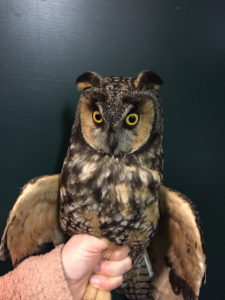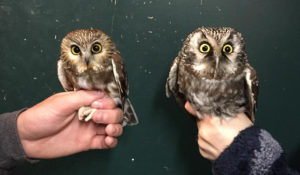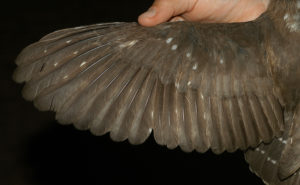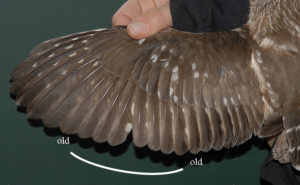Although the recent weather patterns have not been particularly good for banding, the owls have remained fairly steady. The weather has also cooperated by giving us a few nights off this season, which our legs appreciate given how rough the conditions have been for snowshoeing recently. In our last post, we mentioned having seen the first Long-eared Owl of the season, which did prove to be a good omen as the first of the season was banded the following night. After the first Boreal Owl of the season arrived on April 17, we were disappointed to then go eight nights without banding any. Thankfully, Boreal Owls have picked up a little in recent nights, and we have now banded eight this spring. The saw-whets remain slow but steady, and we are now at 108 banded and nine recaptured. The weather does not look particularly good for the next few nights, but hopefully, the owls continue to remain steady until the weather patterns improve.

The first Long-eared Owl of the season.

A Northern Saw-whet Owl (left) and a Boreal Owl (right). The difference in the look in their eyes is very indicative of their different personalities. Saw-whets are very calm and great to work with, whereas Boreal Owls can be much fiestier.
This winter, we were very excited when a paper on Northern Saw-whet Owl patterns that Nova had been working on for years was published in the Journal of Raptor Research. She and Gene Jacobs from Steven’s Point, Wisc., went over recapture data generated from over 50,000 saw-whets banded at WPBO, Steven’s Point, and Hawk Ridge Bird Observatory in Duluth to reinforce and refine how banders assign ages to saw-whets. We figured we’d take the opportunity to give an elementary introduction to the first flight feather molt of saw-whet owls here.
First, as many of you likely know, there are official 4-letter codes used by researchers for bird names, and the code for Northern Saw-whet Owls is NSWO. Like other birds, NSWO grow their first set of flight feathers in simultaneously, resulting in all their flight feathers appearing uniform in color. After that, they perform an incomplete flight feather molt every summer prior to fall migration. That incomplete molt results in a mix of old and new feathers, where the old feathers appear paler than the newer feathers. Although the number of feathers different individuals replace in any molt varies significantly, it is very clear that the priority in the first molt for NSWO is replacing the outermost primaries, the feathers closest to the wingtip, and the innermost secondaries, the feathers closest to the body. So, for about the first year of their lives, NSWO have one generation of flight feathers that are effectively uniform in color. After their first molt, they have new feathers out at the wingtip and close to the body, with a block of old, paler feathers at the center of the wing.

A juvenile NSWO with one generation of flight feathers.

A NSWO after its first flight feather molt, showing new feathers at the wingtip and close to the body.

Another NSWO after its first molt. The contrast between the new and old feathers is more subtle on this owl.
Again, this is a very basic description of this molt. There are more variations than shown here, but these are fairly typical examples of NSWO after their first molt.
Chris Neri & Nova Mackentley
WPBO Spring Owl Banders
If you are considering visiting the Point, please read this important message from Michigan Audubon and WPBO Field Staff.
Maneuvering the ever-changing implications of COVID-19 has necessitated constant adaptation and evaluation for us all. Michigan Audubon and WPBO have been proactive in taking measures that protect our staff, our physical community in Paradise, and the Michigan birding community, and we have found American Birding Association’s recent guidelines on birding and social distancing a useful resource for guiding bird-related travel decisions. While there are hopeful signs that we are rounding the corner with this virus, Michigan Audubon does not want to sow precocious optimism that encourages long-distance travel. Please take a minute to read these ABA guidelines, and to imagine them through the lens of the eastern Upper Peninsula, which does not have the medical resources of Michigan’s more-developed areas. Chippewa County and its adjacent counties have just three hospitals, and only one of these has more than 100 beds; they all are at least an hour’s drive from the Point. WPBO appreciates and requests your continued conscientiousness as the season’s migration begins to ramp up, and does not condone birding travel that is not local. Keep in mind that the Owl’s Roost Gift Shop and public observation of owl banding are currently closed. In the meantime, we will virtually share the Point with you as best we can until it is safe for all parties to enjoy it together. We hope that will be soon.



